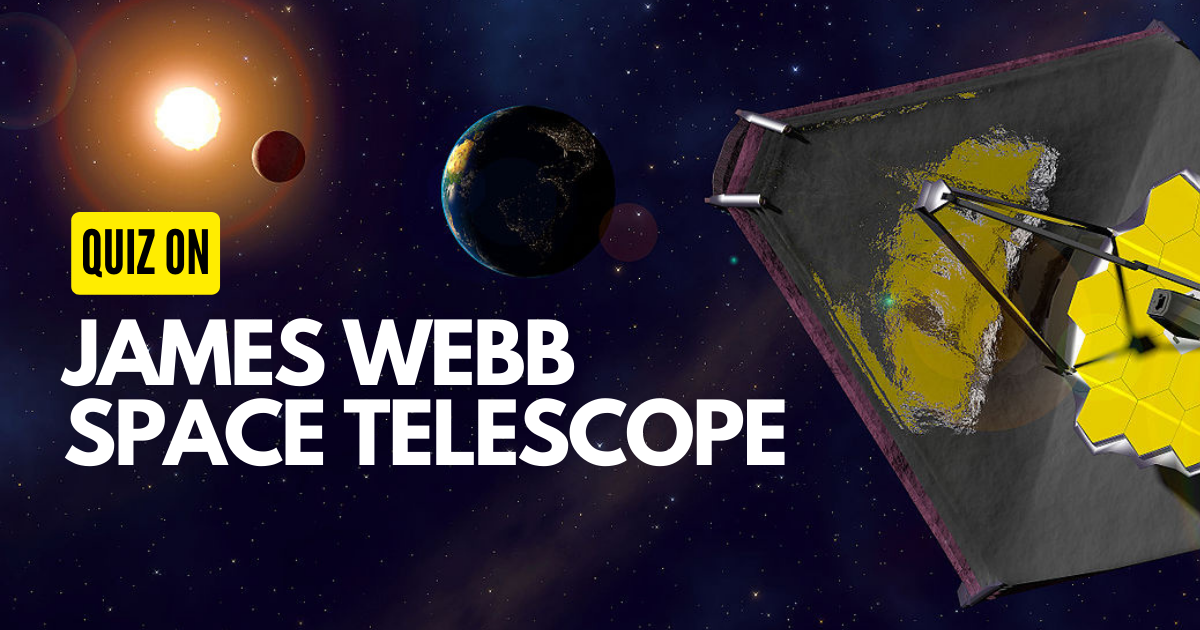Take the Quiz on James Webb Space Telescope, One of the best engineering marvels that humans have ever developed to fulfill their curiosity.
1. JWST stands for
a) James Webb Space Telescope
b) John Webb Space Telescope
c) Jim Webb Space Telescope
d) None
Answer: James Webb Space Telescope
2. JWST is launched on
a) 20th December 2021
b) 20th November 2021
c) 25th December 2021
d) 25th November 2021
Answer: 25th December 2021
3. It launched from
a) New York
b) Texas
c) French Guinea
d) Florida
Answer: French Guinea
Explanation: The launch site is a part of the European Space Agency (Arianespace’s ELA-3) located near Kourou, French Guiana. The launch site is located near the equator where the spin of earth can help in giving additional push to the launch vehicle.
4. Where JWST is placed in space
a) Lagrange 1
b) Lagrange 2
c) Lagrange 3
d) Lagrange 4
Answer: Lagrange 2
Explanation: Lagrange 2 is the right place behind the earth, which helps in blocking out light and heat from the Sun, Earth and the Moon, creating a shade. As JSWT needs a thermally stable location to operate.
5. How many Lagrange points are present in space around the earth.
a) 5
b) 4
c) 3
d) 2
Answer: 5
Explanation: In general there will be 5 Lagrange points in a two body system, these are points where the gravitational pull of two large masses is precisely equal to the centripetal force to make a small object move along with two bodies.
6. What is the distance of Lagrange point 2 from earth
a) 1 million kms
b) 1.2 million kms
c) 1.4 million kms
d) 1.5 million kms
Answer: 1.5 million kms
7. How many mirrors are used in JWST
a) 18
b) 16
c) 14
d) 12
Answer: 18
8. What is the shape of mirrors
a) Square
b) Circle
c) Pentagon
d) Hexagon
Answer: Hexagon
Explanation: Hexagon shape allows for the telescope to have the largest possible reflective surface area to observe. It also has the advantage in folding and unfolding easily with no gaps left between the mirrors.
9. Time period of mission
a) 5 -10 years
b) 10-15 years
c) 15-20 years
d) 25years
Answer: 5 -10 years
Explanation: Initially Webb’s time period was 5-½ years, but the launch was successful. NASA claims that there is enough fuel to support operations for 10years.
10. Which sensors are used in capturing images
a) Guidance Sensor
b) Near Infrared Imager and Slitless Spectrograph
c) UV sensor
d) None
Answer: Near Infrared Imager and Slitless Spectrograph
Explanation: Near Infrared Imager(NIRISS) is a guider which allows the telescope to point an object precisely, to high quality images with a wavelength range of 0.8 – 5 microns.
11. What is the range of JWST
a) 11 billion light years
b) 12 billion light years
c) 13 billion light years
d) 15 billion light years
Answer: 13 billion light years
12. How many layers of sunshield are used to protect the mirrors
a) 3
b) 4
c) 5
d) 6
Answer: 5
Explanation: The Webb’s telescope has 5 layers of sunshield which is approximately the length of a tennis court. Each layer is spaced with a distance to prevent the flow of heat as vacuum acts as a good insulator protecting the telescope.
13. JWST is named after
a) NASA administrator
b) NASA chief
c) US President
d) US senator
Answer: NASA administrator
Explanation: It is named after James Edwin Webb who served as NASA’s administrator from 1961-68. He helped NASA to develop and set up the best lab facilities. He always wanted a major space telescope for observation.
14. Which space agency are involved in making JWST
a) NASA
b) ESA
c) CSA
d) All the above
Answer: All the above
Explanation: It is a joint effort by the National Aeronautics and Space Administration(NASA), European Space Agency(ESA) and Canadian Space Agency(CSA).
15. What types of light spectrum JWST can detect
a) Visible light
b) IR rays
c) Microwaves
d) UV rays
Answer: IR rays
Explanation: Infrared light is electromagnetic radiation with a longer wavelength. Infrared light can penetrate the clouds and allows us to see inside the formation of stars and planets.There are many more reasons to use IR rays to observe them.
We hope you enjoyed the Quiz on James Webb Space Telescope!
Get stories like this one in your inbox: Sign up for our email and Subscribe Now To Get The Most Anticipated Edition Of Starry Stories Magazine For Free.
Learn about James Webb Space Telescope

